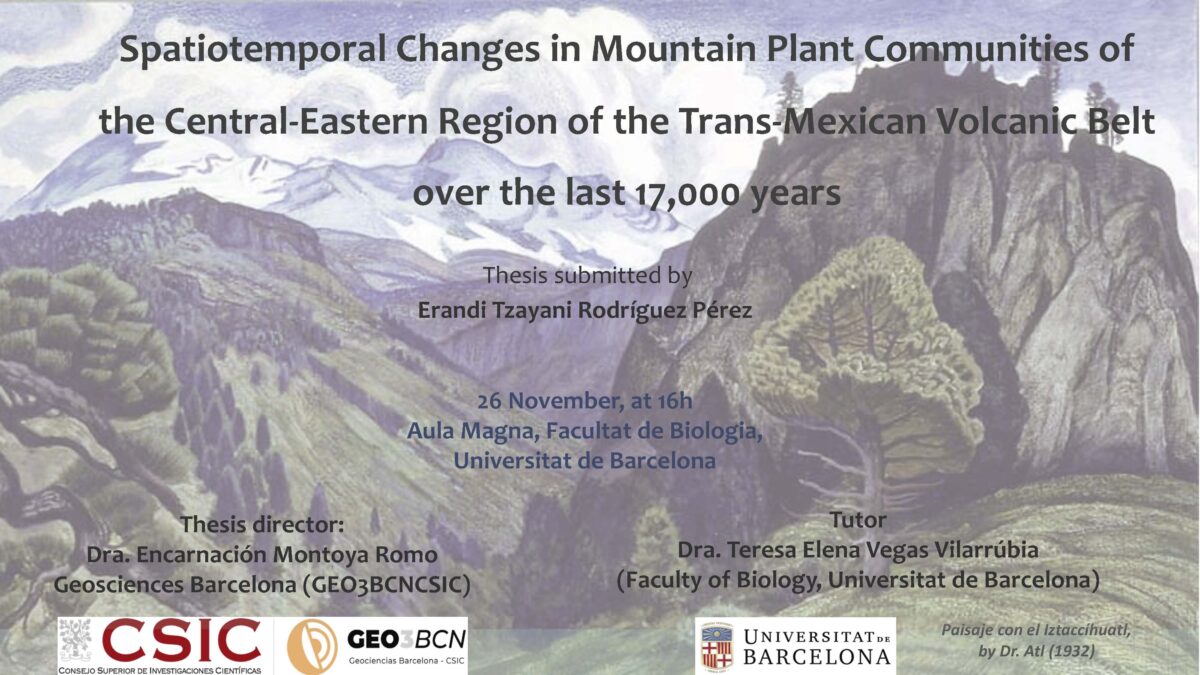Author: Erandi Tzayani Rodríguez Pérez (GEO3BCN-CSIC)
Supervisor: Encarni Montoya (GEO3BCN-CSIC)
Tutor: Teresa Vegas-Vilarrúbia (university of Barcelona)

- November 26th, 2024 | 16:00 PM
- Aula Magna, Faculty of Biology, University of Barcelona (UB)
Abstract
Neotropical mountains are known for their high biodiversity and endemism, providing numerous ecosystem services to the surrounding areas. This research aims to document the changes in the neotropical high mountain plant communities in the central-eastern region of the Trans-Mexican Volcanic Belt (TMVB) during the Holocene. To achieve this, we conducted palaeoecological analyses at two study sites: Cofre de Perote (vCP) and Iztaccihuatl (vIzt) volcanoes in central Mexico. This research studies the pollen within a sediment sequence from vCP and surface soil and paleosol samples collected from several elevation gradients at vIzt. Palaeosol samples were obtained using tephras produced by different eruptions of the Popocatepetl volcano (Tutti-Frutti, Ochre and Pink Pumices) as chronostratigraphic markers. The integration of data from both study sites brink us the following home messages:
- Rising temperatures and glacier retreat during the Early Holocene led to changes in vegetation and the colonisation of alpine grasslands at higher elevations in Central Mexico. This warming also likely contributed to the local extinction of Picea spp. ~9 cal kyr BP.
- Coniferous forests were possibly more closed and/or at higher elevations at sites near the coasts, such as at vCP, compared to inland sites, such as vIzt, during the Early Holocene.
- Around ~7.6 cal kyr BP, Pinus forests possibly colonised elevations similar to present-day elevations (~3800 m asl) in the mountains of the TMVB.
- According to paleosol samples, warm and dry conditions associated with the Holocene Thermal Maximum (HTM) at ~5.7 cal kyr BP may have contributed to establishing open communities in vIzt due to tree taxa being mainly affected by these conditions.
- For the Late Holocene, the data suggest a recent expansion of Abies forests at vIzt and other TMVB sites.
The results of this research show the utility of analysing the pollen signal of palaeosol samples, recovered by the used of tephras as chronostratigraphic markers, to study the spatial composition of the vegetation along elevation gradients. Additionally, the evidence suggests that species with restricted distributions or isolated populations in the TMVB and other neotropical mountains may be especially threatened by current global warming and anthropogenic activities, highlighting the importance of nature reserves and conservation programs.
